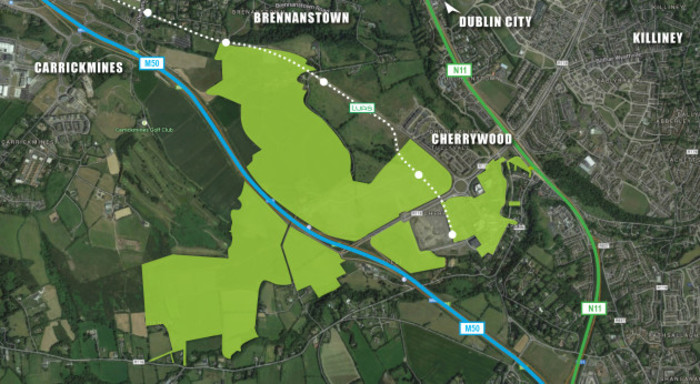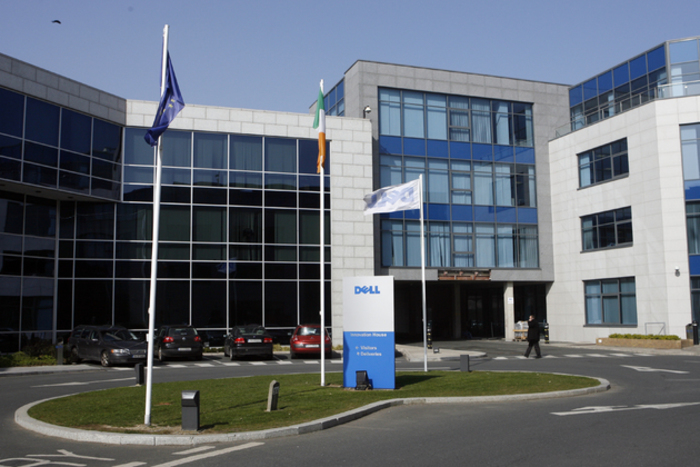After more than a decade, work is finally starting on a 4,000-home Dublin town centre
Cherrywood was left largely undeveloped for years following the economic crash.
TODAY, WORK WILL officially begin on a town centre that has been well over a decade in the making.
Cherrywood in south Dublin has been one of the most high-profile casualties of the crash.
A planned new town featuring almost 4,000 housing units was meant to be developed on one of the most desirable sites in the country, but Cherrywood was largely put on ice after the property crash.
US property group Hines bought the 400-acre site about two years ago, and has started laying the groundwork for building a long-awaited town centre.
Ahead of the ground-breaking ceremony today, Fora spoke to the man leading development of Cherrywood – and we take a look back on the history of the project.
Hines Ireland managing director Brian Moran said that the company has started on upgrading crucial infrastructure, such as the road network in and around the town.
“Today is celebrating the construction of all the utilities and roads. There is about 400 acres of raw land and it has many issues that have to be dealt with,” he said.
“The first thing that we are doing is the road network, then we’re doing gas, sewage and telecoms so that the land is suitable for houses.”
Town centre
After the basic facilities have been laid, the company will look to move on with more advanced development.
Hines plans to apply to build a range of amenities, including bars, restaurants and a cinema, in early April.
The company is also planning to apply for permission to build 1,300 apartments, and as part of a designated strategic development zone the project is primed to pass quickly to the construction stage.
“We hope to have permission by the summer and then be on site by the end of the year,” Moran said.
“It will be two years before the town centre is built with another year before the first facilities come on stream.”
There are plans to eventually build as many as 4,000 housing units in Cherrywood. Moran said that outside of the 1,300 units that are to go ahead in the city centre, how quickly work proceeds on the rest will depend on demand.
 The Cherrywood development site
The Cherrywood development site
“Depending on how demand is we can build faster or slower, (but) our analysis is that demand is strong. I would anticipate that the housing will be absorbed over a five to eight year period.”
Although Cherrywood has faced multiple delays since it was first envisaged almost two decades ago, Hines has been able to progress work reasonably quickly since it acquired the site in 2015.
“From our perspective there was never any doubt in our minds that it would go ahead. We started working on it straight away to get things built as quickly as possible,” Moran said.
“We will have open days for all the people in the border communities to ask questions and we are keen to listen to concerns as we build.”
Here’s a quick rundown of Cherrywood’s chequered history:
The project, plans for which stretch back to the nineties, has had a difficult planning history marked by delays.
The site, located in one of the southernmost areas of Dublin near Foxrock, is the single largest undeveloped land bank in Dún Laoghaire-Rathdown, and is about 400 acres in size.
It was envisaged that it could host a new town that would learn from the mistakes of the past.
 Cherrywood business park
Cherrywood business park
Irish towns, such as Tallaght, have traditionally developed in a piecemeal fashion, with services such as schools and transport links added in after people had already moved to the area.
Cherrywood, like Adamstown in west Dublin, was instead meant to feature infrastructure first, with the people to come after. It was hoped this approach would lead to a more structured and sustainable development.
Although there were buildings as far back as 1998 that had a listed address at Cherrywood business park, work on the project proceeded slowly.
The 2004-2010 local development plan drawn up by the county council laid out the intent to develop the site, but work proceeded slowly. Some development did take place during the boom, most notably the construction of a business park that is anchored by computer giant Dell.
Work stalls
Several houses were also built and some infrastructure has been established, such as the extension of the Luas green line to the town and access to the M50 motorway.
Although much of the town was still not developed, people initially moved in under the assumption that more houses would follow in the near future.
However, work stalled during the economic crash, leaving much of the town empty and large chunks of land vacant. A big chunk of the property was owned by high-profile property developer Liam Carroll.
 Ex-Taoiseach Brian Cowen opens a Luas stop in Cherrywood
Ex-Taoiseach Brian Cowen opens a Luas stop in Cherrywood
When the bulk of his property empire collapsed in the recession, Lloyds Banking Group, along with Danske Bank and AIB, agreed an “asset-management strategy” with some of Carroll’s management staff.
The firm did some minor work at Cherrywood, which resulted in some more life being brought to the area, such as the opening of a Ben Dunne gym. Bad bank Nama, which took control of many of Carroll’s property loans, was also a creditor of Cherrywood.
Sold
Together with Danske and Lloyds, Nama placed much of the Cherrywood development in receivership in July 2014 and began looking for a buyer for the project.
Hines snapped up the project towards the end of 2014, and has been looking to advance work at the site since then.
In 2015 it announced its plans for the site, to build 3,800 housing units in the area and triple the size of the existing Cherrywood Business Park so that it will be able to fit 15,000 workers.
Since then more news as to what Hines plans to do with the area, such as the creation of two new parks, has been revealed in pieces. It is hoped that today’s announcement will finally kickstart serious development in Cherrywood.






